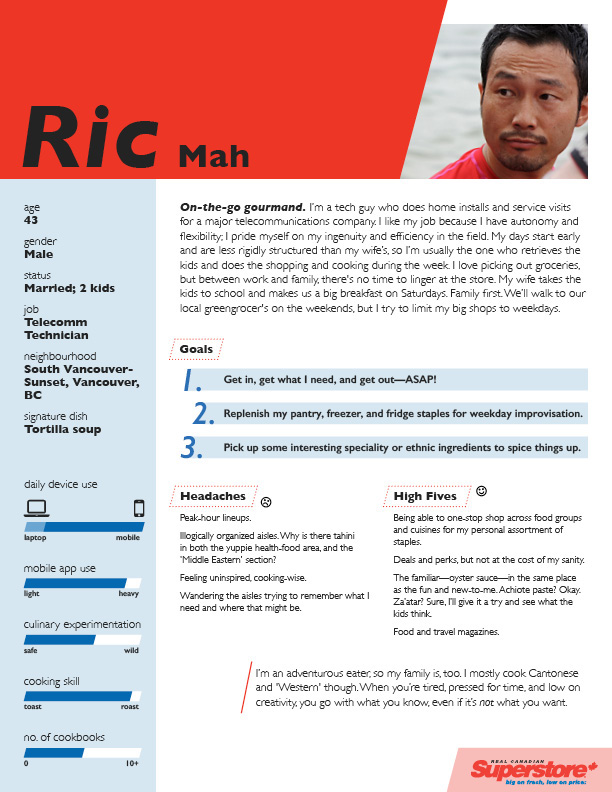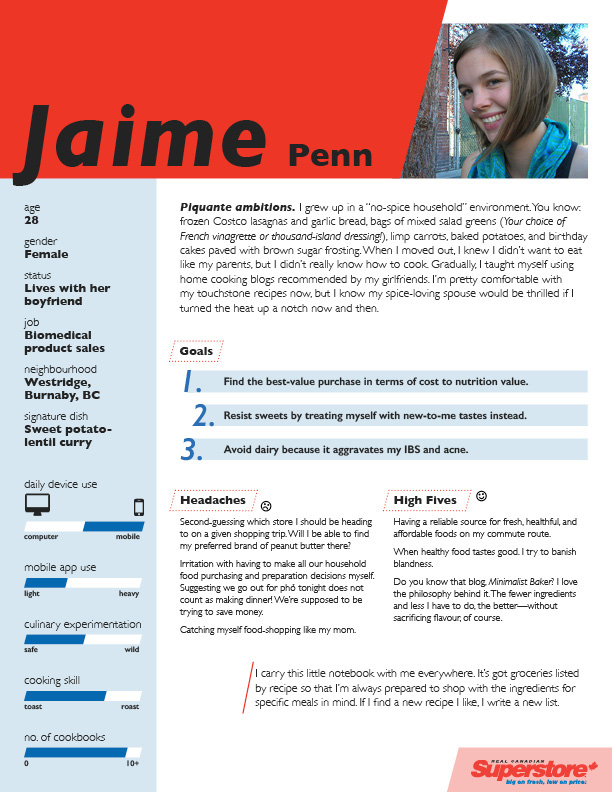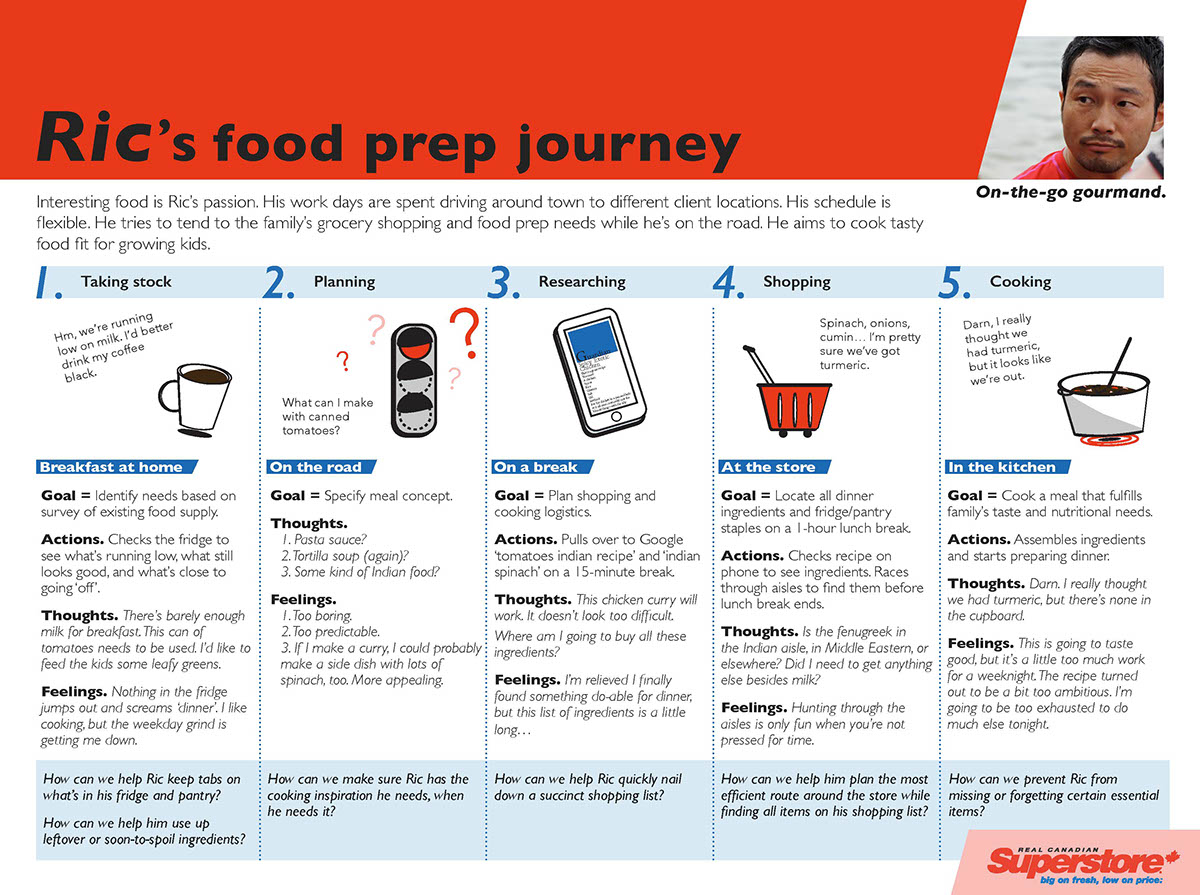Project
User research, persona creation, and journey mapping for a grocery shopping mobile app.
About
My goal for this project was to identify specific Superstore* users and to investigate the particularities of their needs, desires, challenges, and irritations with the aim of eventually designing a user-oriented mobile app.
Contributions
User research and visual design. I completed this project as a student at Emily Carr University of Art and Design.
Tools & Methods
InDesign, user interviews
Context and Premise
Real Canadian Superstore is a chain of large hypermarkets operating across Canada. Their range of products and services is diverse: in the same shopping trip, it’s possible to buy bedsheets, imported cheese, lettuce, lotus root, and a pair of shoes—all while having your prescriptions filled and your photographs printed. With such diverse offerings, Superstore’s model is one that offers something for everyone, but a downside of this approach is that it could potentially be construed by users as offering 'nothing for me'.
I wondered, could a mobile app improve the experience of shopping at Superstore?
Approach: Starting with Users
For this project, I followed a user-centred process that involved conducting interviews, creating personas, constructing a user journey map, and coming up with a concept for a design solution. The vehicle for this solution—a mobile app—was in this case predetermined. However, while I was able to identify two user groups who would be likely to try and benefit from a new Superstore app, I also identified some groups that might be better served by another kind of solution in the environmental or service design realm. A truly user-centred process would have allowed for the possibility of creating such solutions; however, based on the constraints of the assignment brief, I limited myself to researching and designing with the specified mobile app product type in mind.
My first step was to get aquainted with Superstore’s users and non-users. I visited Superstore, Kin’s Farm Market, No Frills, Safeway, London Drugs, Granville Island Market, and small greengrocers to observe shoppers in action and to conduct brief, on-location interviews to probe for motivations behind certain behaviours. I also read online reviews to learn about users’ experiences in their own words and images. I conducted longer, semi structured interviews in person with people I encountered at bus stops and in other sit-down or waiting situations. Overall, I tried to keep my tone conversational and aimed for depth rather than breadth of questioning. I needed to build trust, especially in longer interviews, because when appropriate, I also wanted to gather information about people’s lifestyles: their commutes, their occupations, the people in their households, whether they had pets, their neighbourhoods, etc.
Creating Personas
I reviewed my notes to look for repeated instances of specific categories of behaviours, interests, and preferences between the interview subjects. I then sorted interviewees in relation to each of these, and took note of high-frequency instances where numerous people were clustered around certain expressions of each category. This was one of the most difficult parts of the process, because I didn’t want to force a pattern where there was none. To summarize this phase in my research, I created user personas by identifying possible groupings of the interview subjects, and ultimately ended up with these two: Jaime and Ric.

Photo: 'Freckles' © 2010 available on Flickr under a generic Creative Commons CC 2.0 attribution license. The photographer is not affiliated with this project and does not endorse it in any way.

Photo: © 2010 Satomi Yoneda. All rights reserved. Permission for use and modification obtained September 2015.
Mapping User Journeys
Next, I created journey maps to work out how Jaime’s and Ric’s experiences surrounding food purchasing, preparation, and consumption played out over the course of a typical day. I drew on the personas to articulate goals, actions, thoughts, and feelings at each phase. Rather than expressing touchpoints in terms of interactions with Superstore, I emphasized touchpoints with food in general. In doing so, I left open the possibility of creating an app that answered to the needs of grocery shoppers, and not just grocery shoppers who are already Superstore customers. I tracked both positive and negative emotions (pain points) as 'feelings', but drew attention to opportunities for design interventions by posing questions.

Photo: 'Freckles' © 2010 available on Flickr under a generic Creative Commons CC 2.0 attribution license. The photographer is not affiliated with this project and does not endorse it in any way.
Next Steps
The questions that arise from the journey mapping process will lead my design strategy. I have brainstormed possible app features and used an affinity diagram to map these to the pain points highlighted by the journey map questions. My next step will be to create a site map to illustrate how a mobile app might integrate these features within its architecture and, in doing so, address identified user needs.
* Real Canadian Superstore ('Superstore') is my fictional client for this assignment. Superstore’s logo is used here without permission for the purpose of demonstration only. Superstore is not affiliated with and does not endorse this project in any way.



